Dr. Phil Zeltzman’s Blog
Cartier and the giant surprise…
Cartier, a 12 year old, 10 pound Shih Tzu, was originally seen by her family vet for a walnut-sized mass on the right side of her chest. It looked like a simple skin mass.
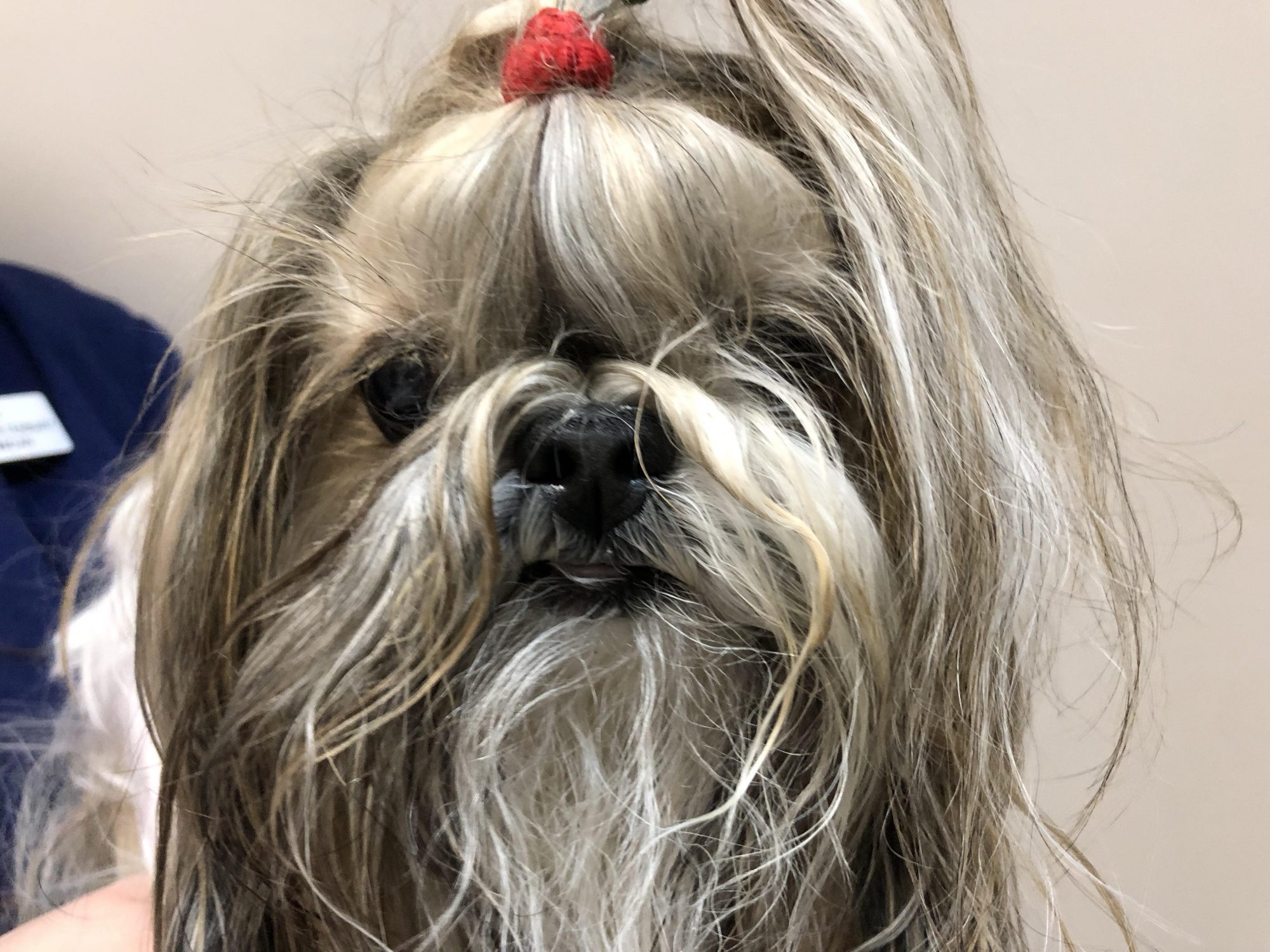
But she soon developed some rather troubling symptoms that had her owners seriously worried. She became lethargic, had difficulty breathing, and even passed out on occasion. What was happening?
Cartier was taken back to her family vet, where X-rays and blood were taken to find out what was going on. The blood work was normal, but shockingly, X-rays revealed that Cartier’s skin mass extended deep into her chest. It was so large, that it crossed to the other side of the chest!
The X-ray below shows the skin mass (green arrow), the chest mass (red arrow) and the heart (blue arrow).
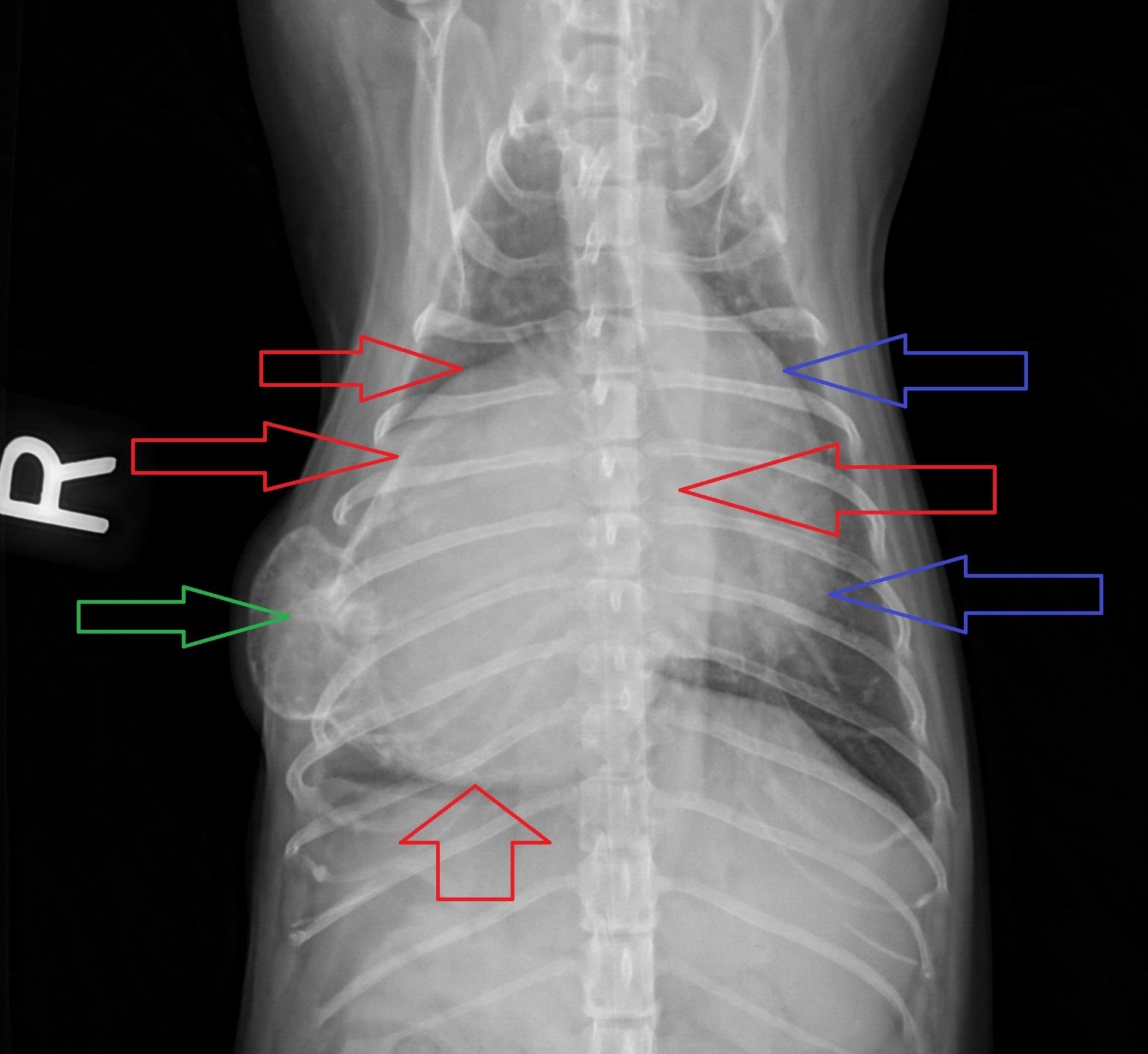
A cat scan of the chest was then performed to better understand what was going on inside the chest, and to make sure the mass had not spread anywhere. There was only one mass (between the colored arrows) but it was almost three times the size of her heart! This explained her symptoms. The only option to help Cartier was to remove the mass.

So I was called in to perform the surgery. On X-rays and on the cat scan, the mass appeared to involve a single rib, but that meant that several ribs would have to be removed in order to successfully remove the mass.
A total of 3 ribs had to be removed, along with the mass, without damaging the heart, the lungs, or any other vital structure. And remember, Cartier only weighed 10 lbs…
By the time we got done, the defect in the chest wall was so big, that it was not possible to put the remaining ribs back together. So the defect was reconstructed with nylon mesh in order to close the chest cavity.
Next, air from her chest had to be removed to allow her to breathe on her own once anesthesia was over. So we used a special plastic drain called a chest tube. Surgery was delicate, but it went well and Cartier bounced back remarkably quickly for an older lady. This is a video of her, walking around the day after surgery (chest tube still in place).
The chest tube was removed a few days after surgery and she went home safely.
The mass was sent to the lab to be biopsied. One week later, the results came back as bone cancer (osteosarcoma). This was one of the 2 most likely diagnoses. The other most likely possibility was cartilage cancer (chondrosarcoma).
One month after surgery, Cartier’s owners were happy to report that she had more energy, ran around, had bright eyes, and seemed to be back to normal. Her personality had come back, she had a hop in her step, seemed much more comfortable and no longer struggled to breathe.
Twelve year old Cartier now had a new lease on life.
Her owners said: “we couldn’t have asked for better results.”
Addendum:
I am thrilled to report that as of July 2019, Cartier, the now 13 year old, is still doing well.
This is 7 months after surgery.
Phil Zeltzman, DVM, DACVS, CVJ, Fear Free Certified
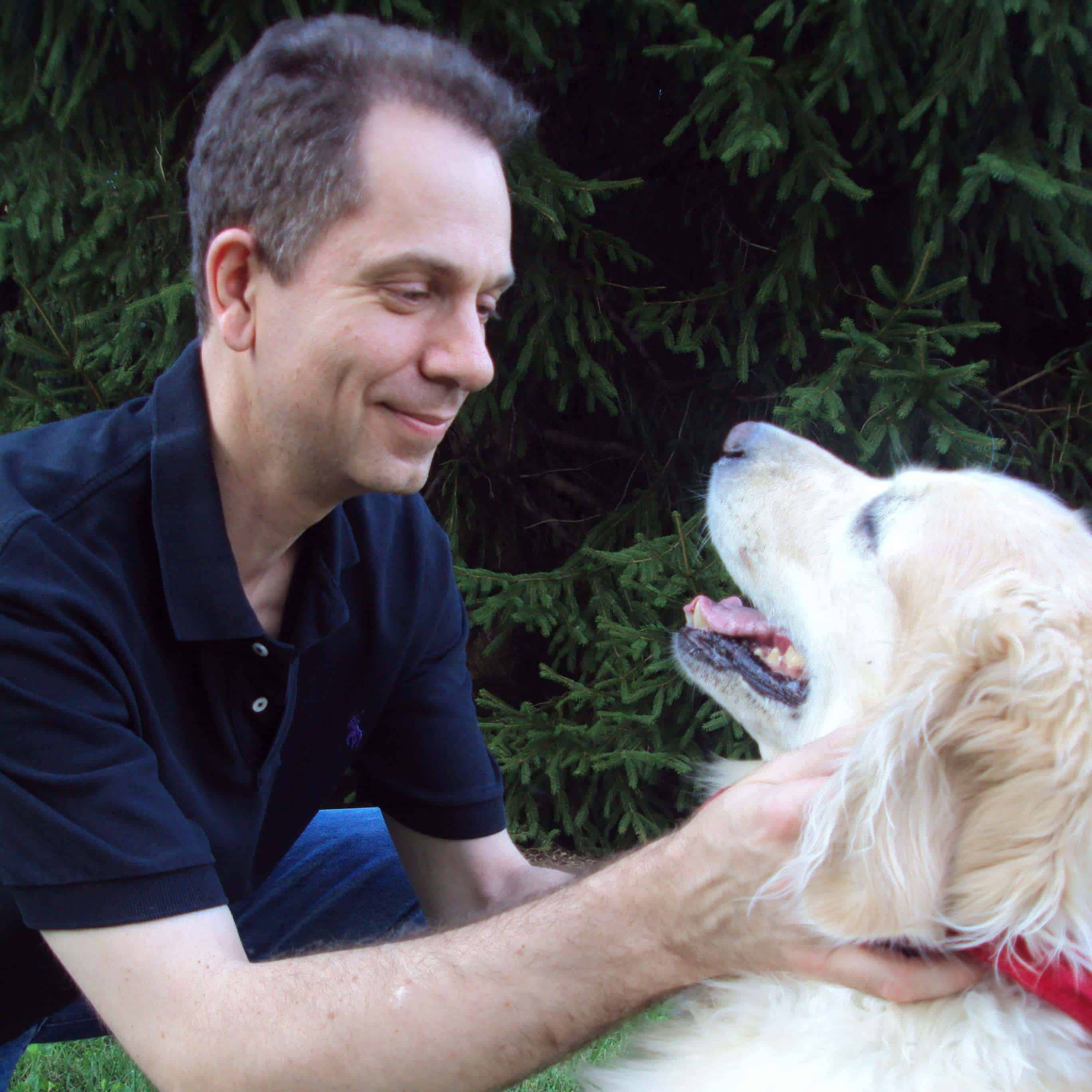
Dr. Phil Zeltzman is a traveling veterinary surgeon in Pennsylvania & New Jersey. An award-winning author, he loves to share his adventures in practice along with information about vet medicine and surgery that can really help your pets. Dr. Zeltzman specializes in orthopedic, neurologic, cancer, and soft tissue surgeries for dogs, cats, and small exotics. By working with local family vets, he offers the best surgical care, safest anesthesia, and utmost pain management to all his patients. Sign up to get an email when he updates his blog, and follow him on Facebook, too!
What you need to know about “bloat”
A surprising number of pet lovers have dogs at risk for “bloat”, yet they don’t know much about the condition.
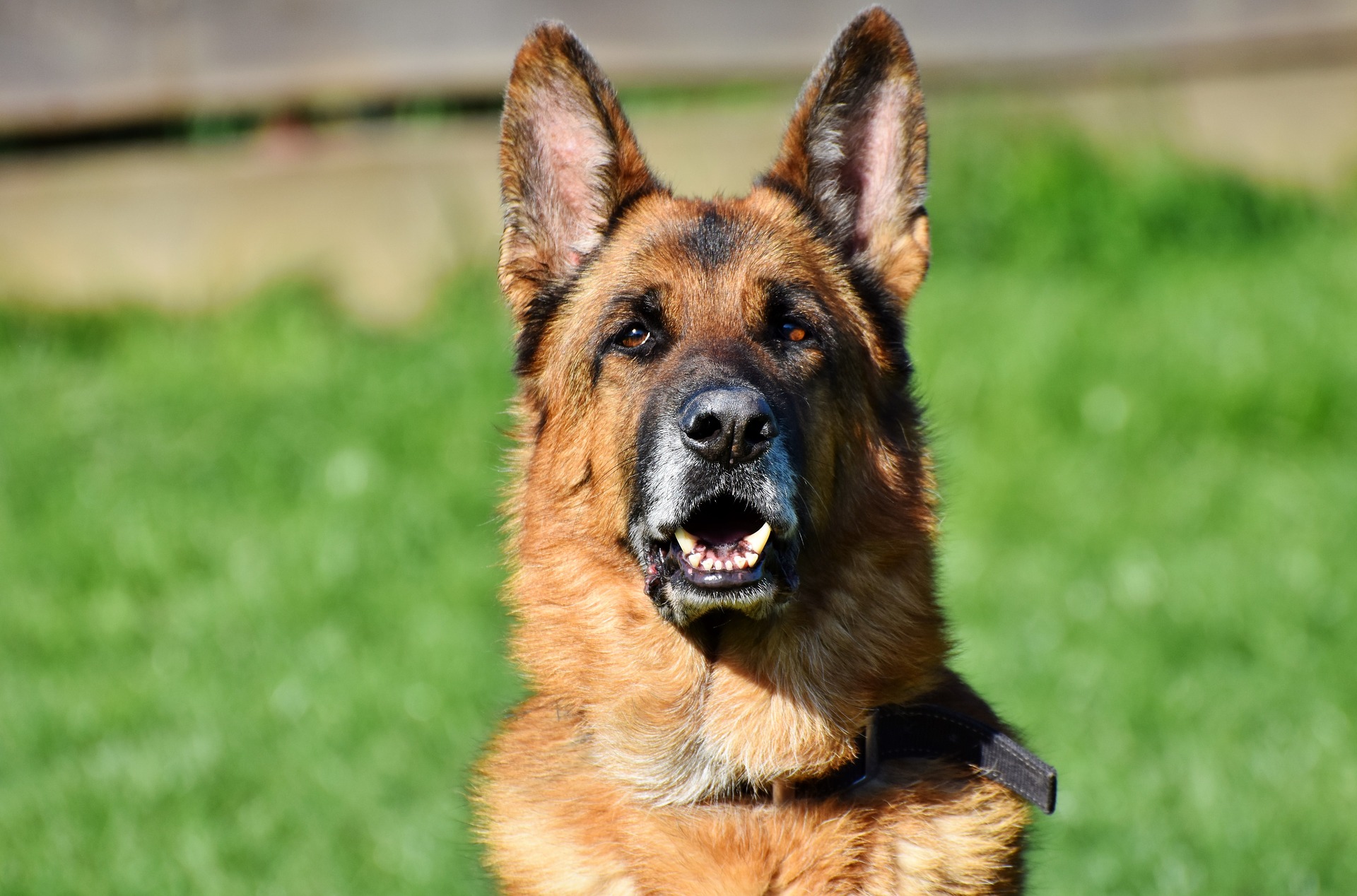
If you own a dog at risk, it is very important for you to know about it.
What is GDV?
Bloat is a life-threatening condition with many synonyms, including twisted stomach, gastric dilatation and gastric torsion. The medical expression is Gastric Dilatation Volvulus (GDV), which is what vets typically call it.
In this condition, a dog’s stomach distends with air to dramatic proportions (see X-ray). This is called gastric dilatation (GD). An X-ray of the belly would show a “single bubble”, which means that the stomach contains air in a single “pocket”.
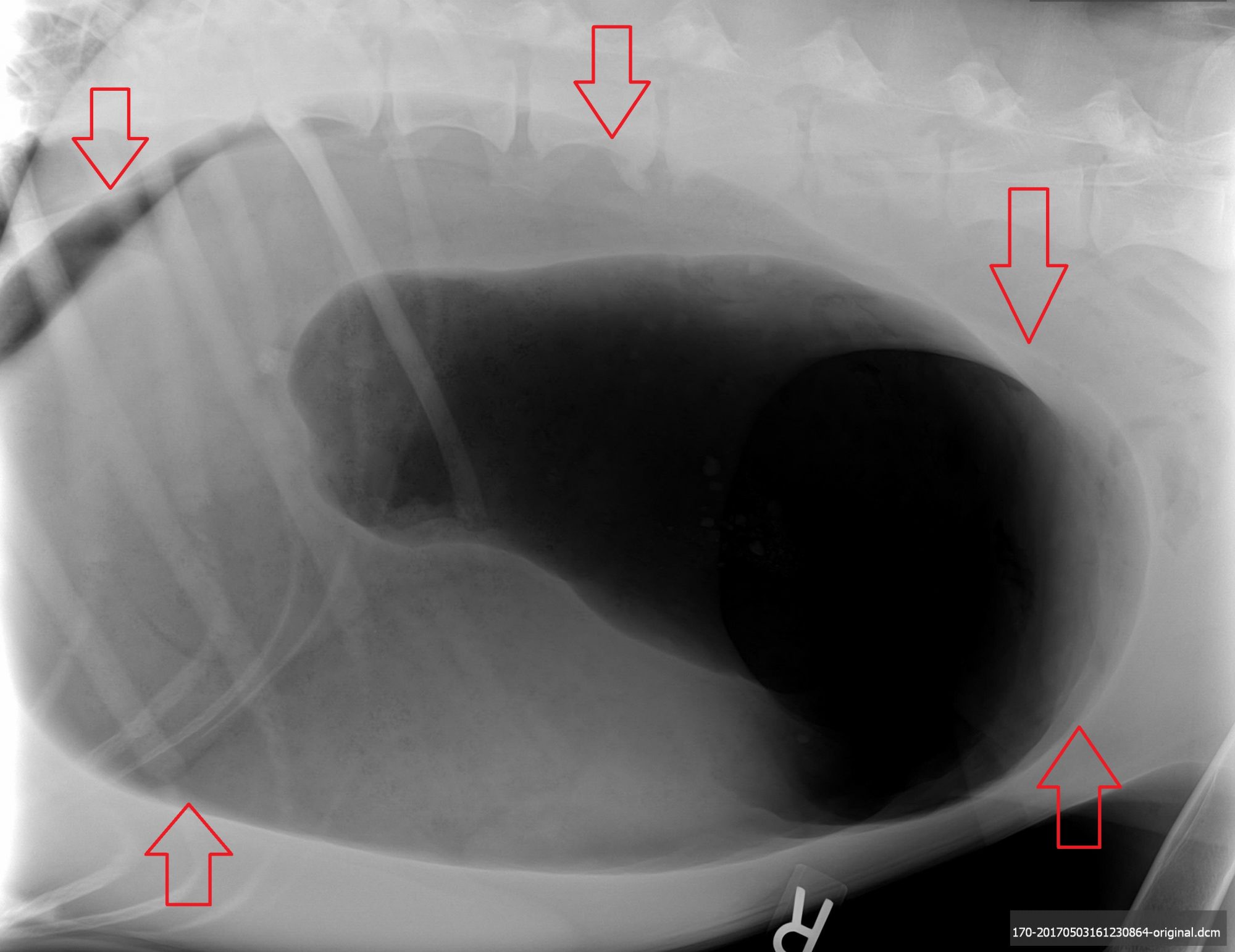
A classic example of the “single bubble” of GD in a German Shepherd. The arrows show the size of the stomach
The stomach can also twist onto itself, cutting off blood supply to the stomach and other major organs. It also blocks the exit of air and stomach contents. This is called Gastric Dilatation Volvulus (GDV). An X-ray of the belly would show a “double bubble”, which means that the stomach contains air in 2 separate “pockets”.
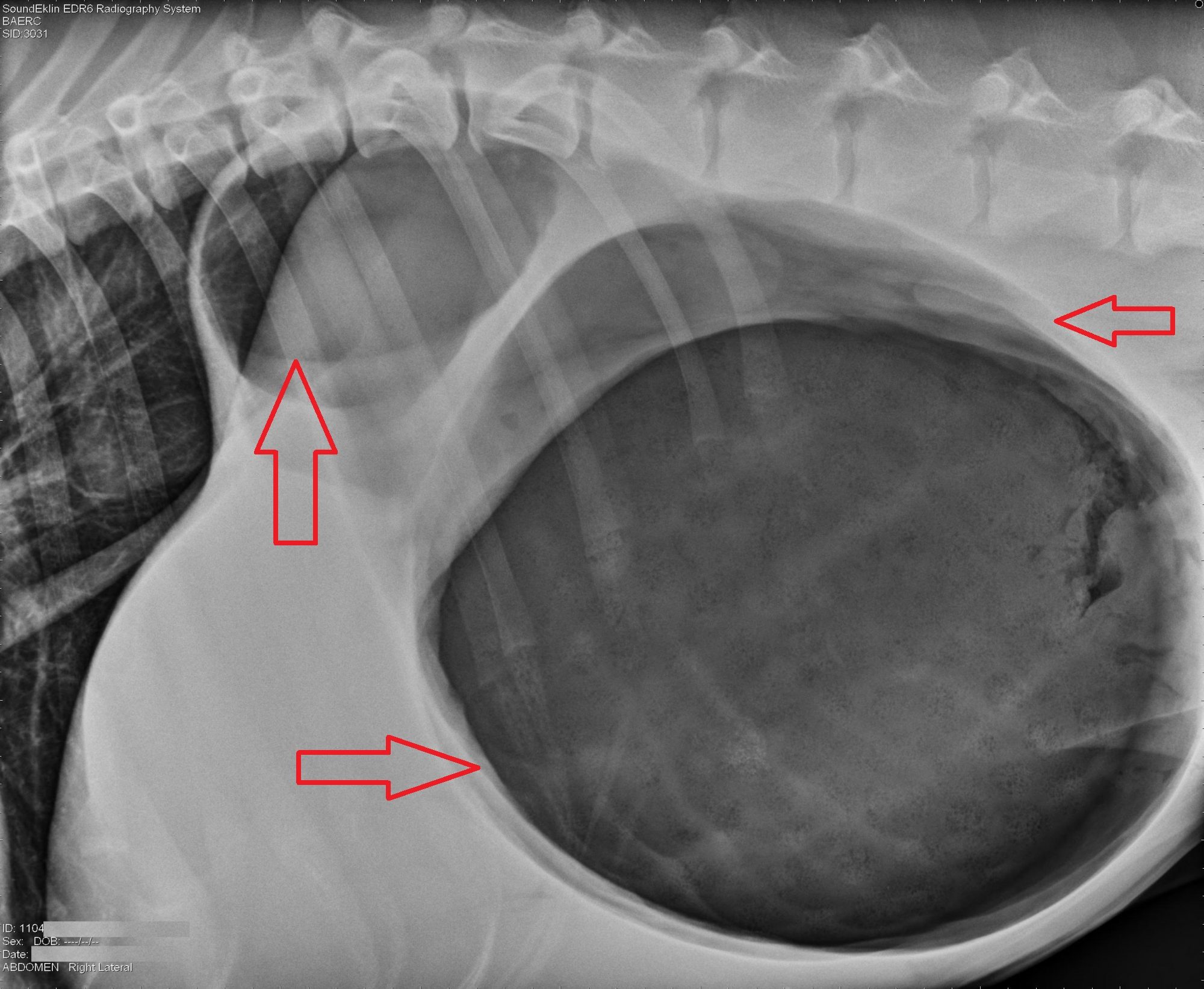
A classic example of the “double bubble” of GDV
Obvious signs of GDV include a huge (bloated) belly and “retching”, which means unsuccessful attempts at vomiting.
Less obvious signs of GDV include pacing, salivating, restlessness, inability to lie down, a distressed attitude, rapid breathing, and pale gums.
What causes GDV?
There are many risk factors. Some are questionable if not plain ridiculous. Here are a few scientifically proven causes of GDV.
* Large and giant breeds are at higher risk for developing GDV. Breeds such as Great Danes (the number 1 breed), Mastiffs, German Shepherds, Old English Sheepdogs, Weimaraners, and St. Bernards are all at risk but it also occurs in smaller breeds like Boxers, Basset Hounds and Standard Poodles.
* The disease is related to the dog’s body conformation, i.e. his or her shape. Deep chested dogs are more likely to have GDV. This picture of a Great Dane is a great example of what we mean by deep chest.
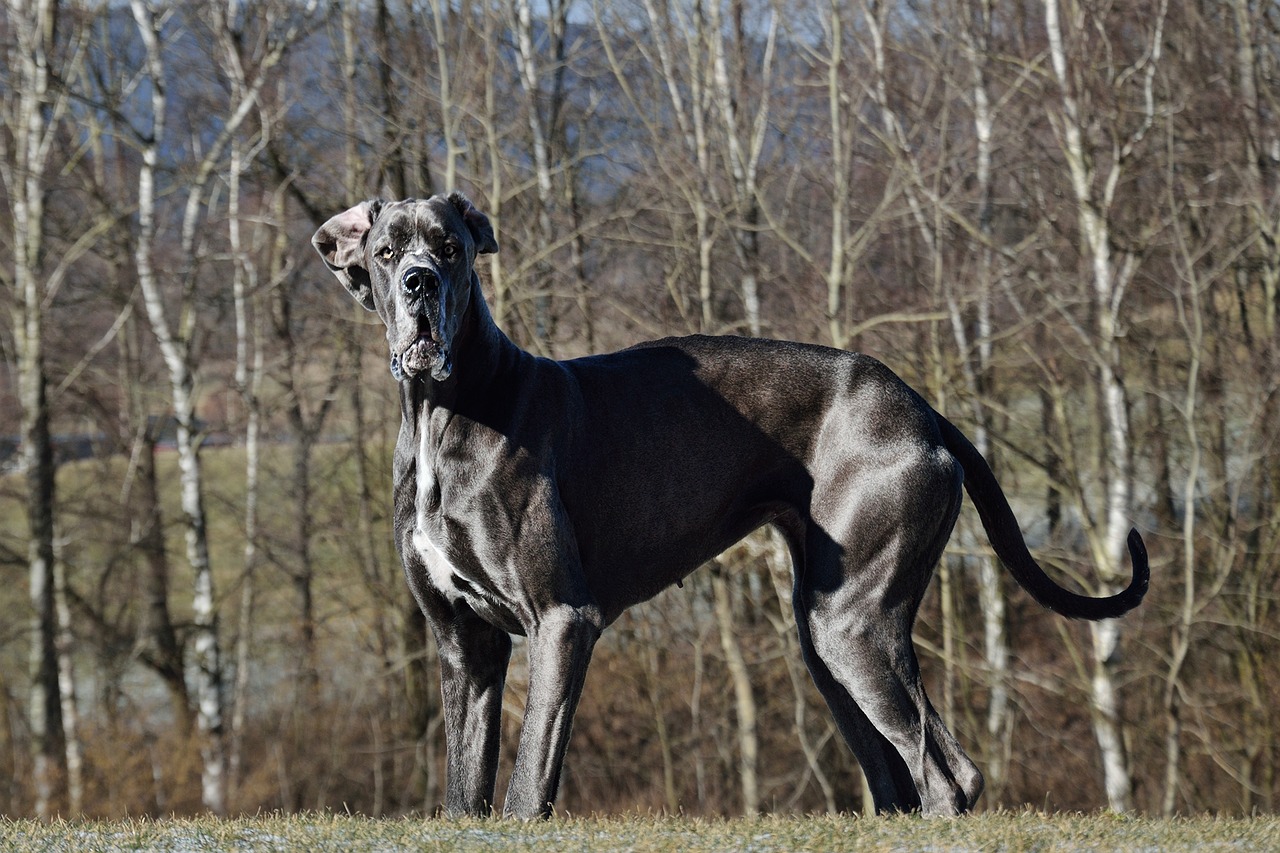
* Developing GDV can also be partially genetic: a dog related to a dog who suffered from GDV is at a 20% higher risk.
* Stressful situations or environments can contribute to GDV. We know that dogs who are boarded can bloat, possibly from being stressed out. The same applies to storm and fireworks.
* Food and water intake have been a commonly heard cause of GDV. Rapid eating, once daily feeding, and the type of food given can all be a factor in GDV risk. Too much water prior to vigorous exercise or prior to/during meals are believed to play a role in the development of GDV.
* Age can play a role in GDV. As dogs age, they experience some changes in their abdominal cavity (e.g. stretching of ligaments of the stomach), which can increase their risk.
Prevention
While scary and life-threatening, the twisting of the stomach can be prevented with surgery. Dogs at a higher risk for suffering from GDV can have a preventive surgery called a prophylactic gastropexy, or “pexy” for short.
This surgery entails stitching the stomach to the inside of the belly. When performed by someone experienced, it dramatically decreases the risk of the stomach twisting. This simple procedure can be done at the same time as a spay or a neuter.
The picture below shows the end result of a prophylactic gastropexy after a recent patient of mine, Zeke, a 1 year old German Shepherd, was neutered.
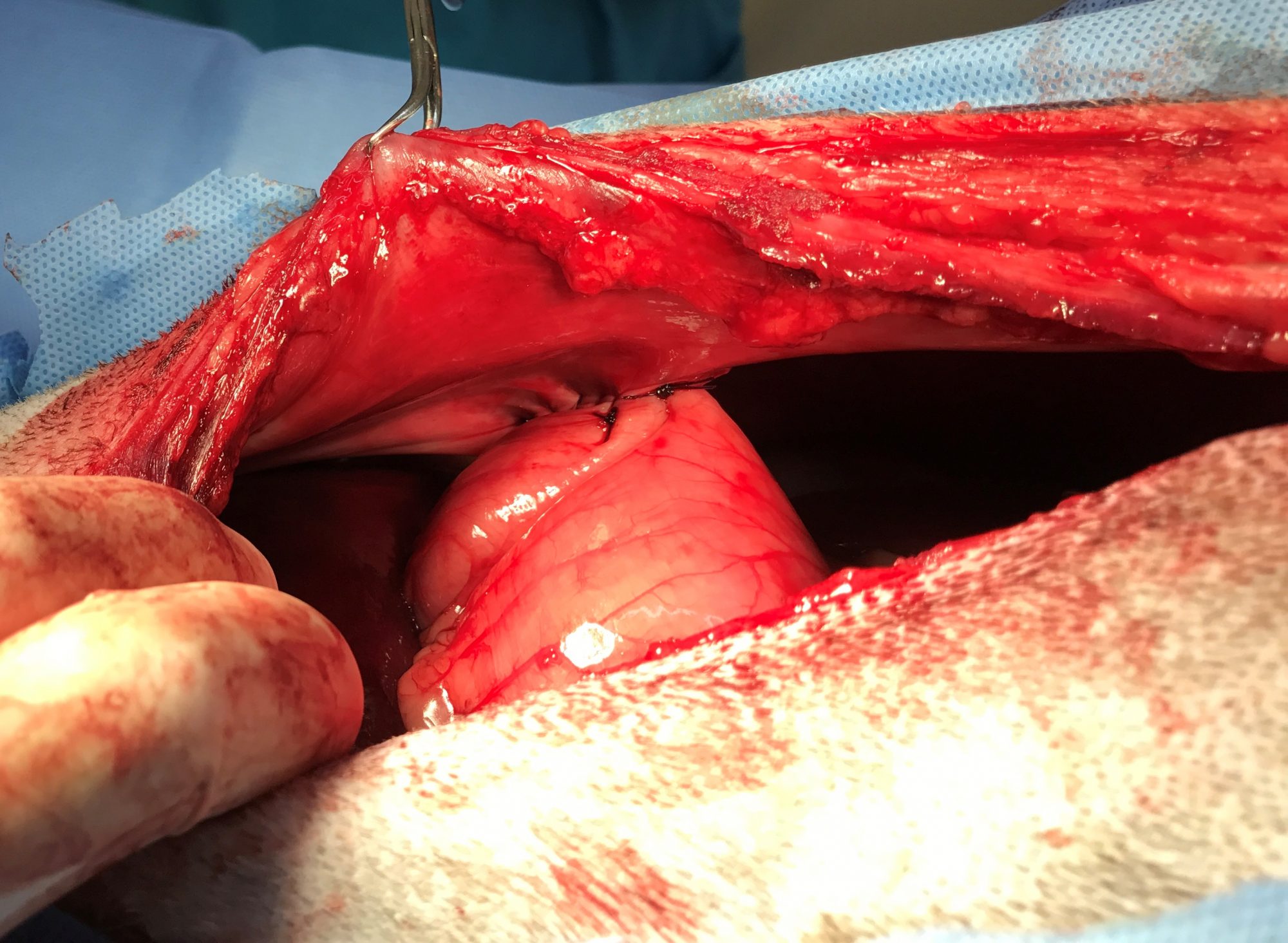
Very importantly, the dog can still “bloat” (a terrible, very misleading name) after a prophylactic gastropexy. It’s meant to prevent the twisting, not the “bloating.”
Should it happen, the dog must be rushed to the closest vet or ER to pass a tube into the stomach to remove the air, followed by stabilization with IV fluids etc.
Treatment
If a dog’s stomach has distended and twisted, surgery entails:
. Removing the air from the stomach ASAP.
. Repositioning the twisted stomach in its natural position.
. Performing a gastropexy (see above).
. Assessing the spleen, which can be damaged and may need to be removed.
. Looking at every organ in the belly to make sure nothing else needs to be addressed (“exploratory laparotomy”).
For additional information about Gastric Dilatation-Volvulus, follow this link to read a more in-depth article I wrote for veterinarians:
www.veterinarypracticenews.com/what-causes-gastric-dilatation-volvulus
Phil Zeltzman, DVM, DACVS, CVJ, Fear Free Certified

Dr. Phil Zeltzman is a traveling veterinary surgeon in Pennsylvania & New Jersey. An award-winning author, he loves to share his adventures in practice along with information about vet medicine and surgery that can really help your pets. Dr. Zeltzman specializes in orthopedic, neurologic, cancer, and soft tissue surgeries for dogs, cats, and small exotics. By working with local family vets, he offers the best surgical care, safest anesthesia, and utmost pain management to all his patients. Sign up to get an email when he updates his blog, and follow him on Facebook, too!
4 (More) Truths about Pet Expenses
As promised last time, here are 4 other financial concerns to consider with your beloved furry friend.
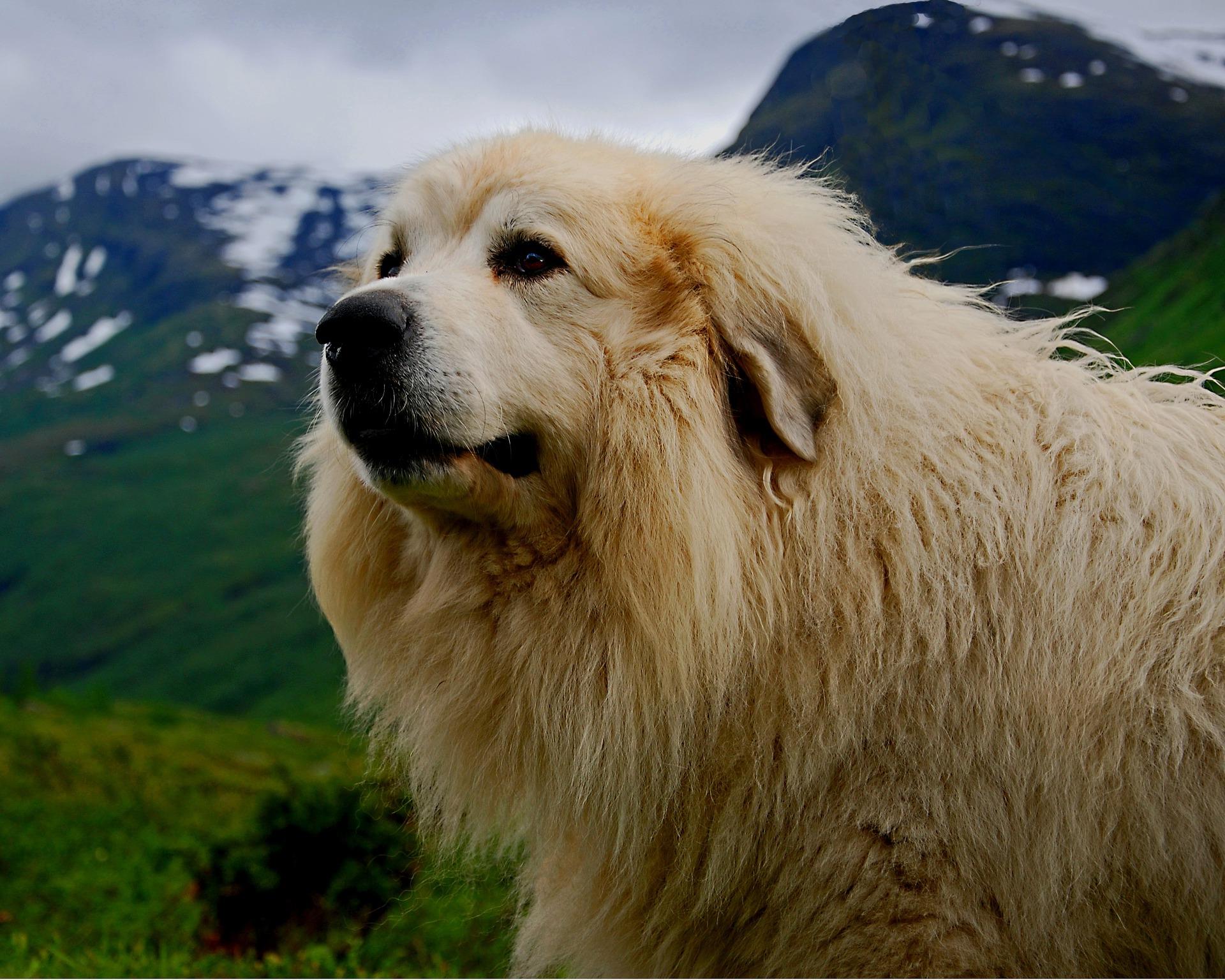
1. Skipping basic pet care can drastically increase costs
As Ben Franklin said, “An ounce of prevention is worth a pound of cure.” Here are five perfect illustrations of that quote:
. Regular dental cleanings are cheaper (and less painful) than a major dental procedure.
. Preventing internal parasites (e.g. worms) is cheaper than treating their consequences, such as vomiting or diarrhea.
. Preventing external parasites (e.g. fleas) is cheaper than fighting their effects, such as skin irritation or infection.
. Nipping small health problems in the bud is cheaper than treating the full-blown disease.
. Vaccinating your pet is always much cheaper than treating any of the diseases vaccines prevent so effectively. In addition, some of these diseases, such as the one caused by parvovirus, can be deadly.
Treating diseases like those can cost over 100 times the preventive care cost — not to mention that you can lose your pet altogether.
2. Pet proofing your home is worth the investment
Pet proofing your house is very important to try to prevent the need to surgically remove something that your pet should not have swallowed.
Ultra-classic examples include socks, toys and “string” type foreign bodies.
3. Feeding veterinarian-approved pet food will cost less in the long run
All pet foods are the same, right? Wrong! Without the proper diet, your dog or cat can develop many different diseases including:
Overweight or obesity
Skin conditions
Heart disease
Malnutrition
Bladder stones
Urinary blockage in cats
Metabolic issues
Proper nutrition can prevent health problems and large expenses.
4. Pet insurance is not an investment
I am a firm believer that pet insurance can be a life-saver. With one huge caveat: you need to pick the proper plan. They are some very good ones and some very bad ones.
I’ve heard pet owners complain “I’ve paid for pet insurance for years, and I never recouped my investment, so I stopped paying for it.”
Insurance is not an investment! It’s protection against a big expense in case of a serious medical or surgical situation.
Would you ever say “I’ve paid for fire insurance for years, and my house never burned down, so I stopped paying for it?”
Of course not!
Pet insurance gives you the peace of mind that you will be able to care for your pet, should there be a health crisis.
Life as a pet lover can be tough, but by taking the proper steps you can help alleviate the financial burden and take proper care of your loved ones.
Phil Zeltzman, DVM, DACVS, CVJ, Fear Free Certified

Dr. Phil Zeltzman is a traveling veterinary surgeon in Pennsylvania & New Jersey. An award-winning author, he loves to share his adventures in practice along with information about vet medicine and surgery that can really help your pets. Dr. Zeltzman specializes in orthopedic, neurologic, cancer, and soft tissue surgeries for dogs, cats, and small exotics. By working with local family vets, he offers the best surgical care, safest anesthesia, and utmost pain management to all his patients. Sign up to get an email when he updates his blog, and follow him on Facebook, too!
4 Truths about Pet Expenses
Pet adoption is one of the most gratifying and worthwhile experiences many of us will ever have.

Unfortunately, it can be easy to let yourself get carried away and to adopt a new companion without fully considering the responsibility that it entails.
Sadly, I am regularly faced with pet owners who are not capable of taking care of their friend because they never planned that one day, expensive veterinary care may be on the horizon.
What follows are 4 financial truths that every pet lover should be aware of.
For the most part, this list also applies to cat lovers.
1. There is no such thing as a free pet
Sure, the “rescue” may be free. But every pet you adopt will require food, yearly wellness care and possibly unexpected medical expenses.
2. Adopting a giant dog is more expensive
Great Danes, Newfies and Mastiffs are cool. But if you live on a teacup poodle budget, maybe you can postpone adopting a large dog until you are more comfortable.
Most things are proportional in veterinary medicine: big dogs need larger doses of medications and of course larger amounts of food.
3. Not spaying or neutering can cost you money
Spaying your pet eliminates the risk of a life-threatening infection of the uterus called pyometra. In addition, spaying before the first heat cycle virtually eliminates the risk of breast cancer. Both conditions require – you guessed it – costly surgery.
Neutering your pet decreases annoying behavior, eliminates the risk of testicular cancer, helps prevent prostate diseases and reduces the risk of testosterone-driven girl-chasing incidents that can lead to lost pets and hit by car injuries.
4. Procrastinating can be expensive
Removing a small skin lump is logically less expensive than removing a mass that is large enough to require its own zip code. In addition, surgery is much less invasive early on.
Next time, we will go over 4 more financial concerns to consider.
Phil Zeltzman, DVM, DACVS, CVJ, Fear Free Certified

Dr. Phil Zeltzman is a traveling veterinary surgeon in Pennsylvania & New Jersey. An award-winning author, he loves to share his adventures in practice along with information about vet medicine and surgery that can really help your pets. Dr. Zeltzman specializes in orthopedic, neurologic, cancer, and soft tissue surgeries for dogs, cats, and small exotics. By working with local family vets, he offers the best surgical care, safest anesthesia, and utmost pain management to all his patients. Sign up to get an email when he updates his blog, and follow him on Facebook, too!
Luna, a happy ending despite an agonizing decision to amputate
Luna, an 11 year old shepherd mix, had a large mass (larger than a golf ball) between her toes in the left front leg.
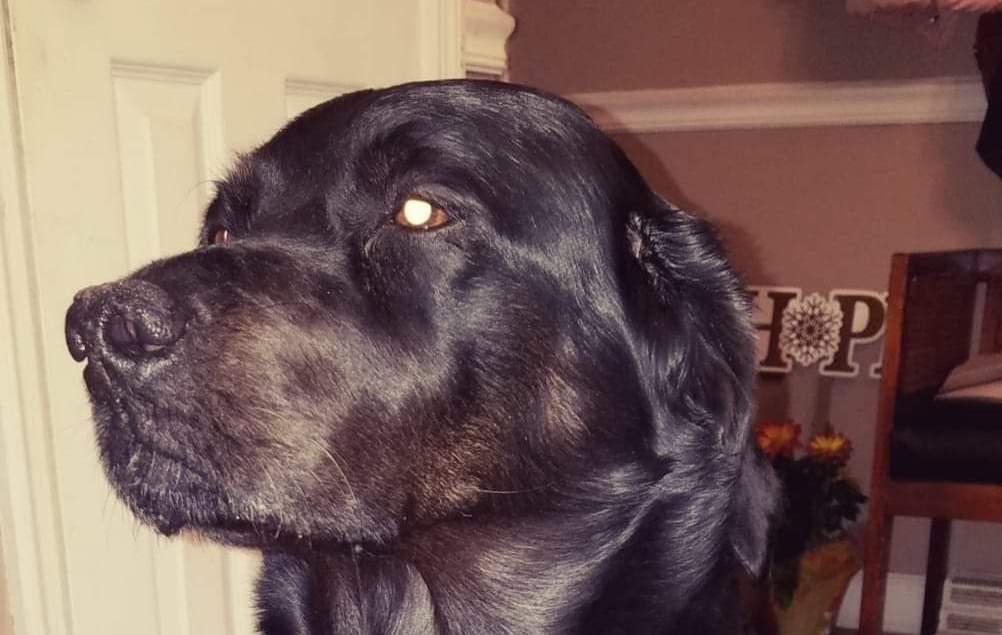
WARNING – WHAT FOLLOWS IS GRAPHIC – YOU HAVE BEEN WARNED.
Actually, the mass got much smaller suddenly, after she literally chewed up half of it. That left a large open wound, which got infected, and caused a horrible smell.
Luna was limping because of the severe pain this mass caused.
Her family vet did a needle test (“fine needle aspirate”), which came back normal or as we say “inconclusive”. So there was nothing to worry about right? It was likely a benign mass after all.
Amputation was mentioned, but Luna’s loving owner could not accept the idea. She thought it was a horrible idea and Luna would be miserable. She found me through my website, reached out to me, and we had a little heart to heart. I explained my concern that this was not a benign mass at all, and that amputation was the only reasonable option.
After agonizing over this difficult decision, Luna’s owner eventually agreed to do the right thing for her beloved dog and scheduled the amputation.
But first, we needed to take chest X-rays, because the cancer I suspected typically spreads quickly to the lungs. Fortunately, no spreading was visible at that point.
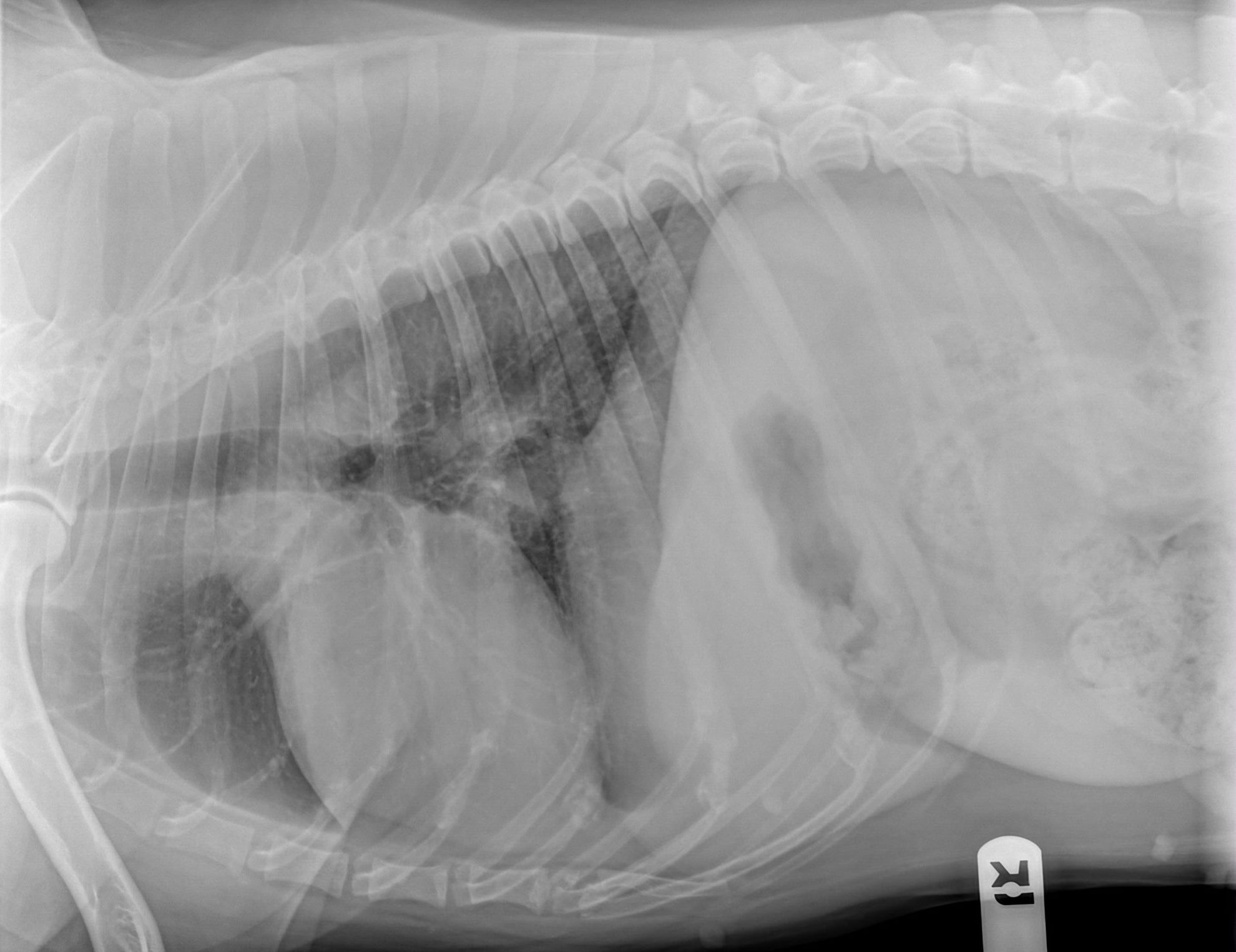
We performed the amputation (let’s call it day 1) and surgery went smoothly. Luna went home that night – walking. Below is a summary of what happened after surgery, to give you a feel for the emotional roller-coaster Luna’s owner went through.
Day 1: surgery was performed. Luna went home and had a rough first night. Of course, Luna’s owner questioned her decision.
Day 2: I recommended adding a third pain medication.
Day 3: One of my nurses called to check in. Luna felt much better already.
Day 5: Luna’s owner wrote: “Hi Dr. Zeltzman, she seems to be doing great so far. She’s acting more like herself each day. She’s just sad she can’t get on the couch or bed.”
Day 6: The biopsy results came back. The news was not good. As expected, the mass was indeed cancerous. It’s called malignant melanoma.
In spite of the bad news, Luna’s owner was relieved that her dog was finally out of pain. She wrote: “Thanks again. We can’t thank you enough for the amazing work you did to her!”
Day 28: Four weeks after surgery, Luna’s owner wrote: “Hi Dr Zeltzman. Just wanted to thank you again for the wonderful care you gave to Luna. She is doing wonderful and living a happy pain free life. I wanted to share a picture of her because she looks so beautiful and happy!”
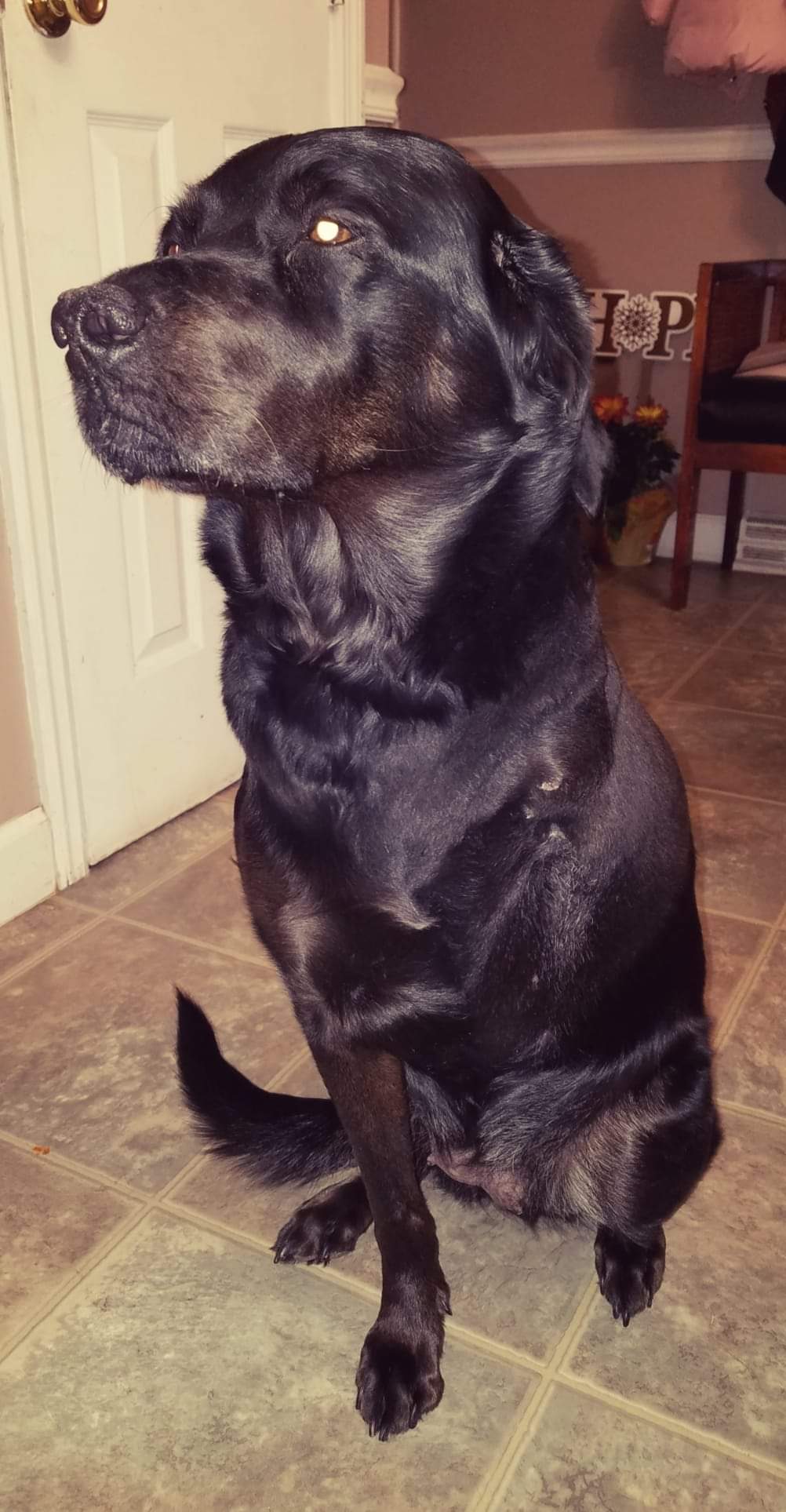
So what is the purpose of this blog? I’m not sharing this story to brag. And I am not here to try to convince you that amputation is a wonderful thing and a walk in the park (no pun intended) .
What I would like pet lovers to believe is that when we recommend sacrificing a leg, it’s never for fun. It’s always to help a cat or a dog feel better, once the source of the pain is removed.
The biggest obstacle is most often in the pet owner’s mind. They are often terrified that amputation is cruel. I suspect that, subconsciously, they think of themselves as an amputee, walking on one leg. Well, remember, pets walk on 3 legs after amputation and they adapt very well. And typically, they start walking a few hours after surgery!
Pets don’t even know they’re missing a leg, all they know if that they don’t feel the pain anymore.
In Luna’s owner’s own words: “She is doing wonderful and living a happy pain free life.”
Phil Zeltzman, DVM, DACVS, CVJ, Fear Free Certified

Dr. Phil Zeltzman is a traveling veterinary surgeon in Pennsylvania & New Jersey. An award-winning author, he loves to share his adventures in practice along with information about vet medicine and surgery that can really help your pets. Dr. Zeltzman specializes in orthopedic, neurologic, cancer, and soft tissue surgeries for dogs, cats, and small exotics. By working with local family vets, he offers the best surgical care, safest anesthesia, and utmost pain management to all his patients. Sign up to get an email when he updates his blog, and follow him on Facebook, too!

